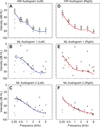Fast, Continuous Audiogram Estimation Using Machine Learning
- PMID: 26258575
- PMCID: PMC4709018
- DOI: 10.1097/AUD.0000000000000186
Fast, Continuous Audiogram Estimation Using Machine Learning
Abstract
Objectives: Pure-tone audiometry has been a staple of hearing assessments for decades. Many different procedures have been proposed for measuring thresholds with pure tones by systematically manipulating intensity one frequency at a time until a discrete threshold function is determined. The authors have developed a novel nonparametric approach for estimating a continuous threshold audiogram using Bayesian estimation and machine learning classification. The objective of this study was to assess the accuracy and reliability of this new method relative to a commonly used threshold measurement technique.
Design: The authors performed air conduction pure-tone audiometry on 21 participants between the ages of 18 and 90 years with varying degrees of hearing ability. Two repetitions of automated machine learning audiogram estimation and one repetition of conventional modified Hughson-Westlake ascending-descending audiogram estimation were acquired by an audiologist. The estimated hearing thresholds of these two techniques were compared at standard audiogram frequencies (i.e., 0.25, 0.5, 1, 2, 4, 8 kHz).
Results: The two threshold estimate methods delivered very similar estimates at standard audiogram frequencies. Specifically, the mean absolute difference between estimates was 4.16 ± 3.76 dB HL. The mean absolute difference between repeated measurements of the new machine learning procedure was 4.51 ± 4.45 dB HL. These values compare favorably with those of other threshold audiogram estimation procedures. Furthermore, the machine learning method generated threshold estimates from significantly fewer samples than the modified Hughson-Westlake procedure while returning a continuous threshold estimate as a function of frequency.
Conclusions: The new machine learning audiogram estimation technique produces continuous threshold audiogram estimates accurately, reliably, and efficiently, making it a strong candidate for widespread application in clinical and research audiometry.
Figures






Similar articles
-
Online Machine Learning Audiometry.Ear Hear. 2019 Jul/Aug;40(4):918-926. doi: 10.1097/AUD.0000000000000669. Ear Hear. 2019. PMID: 30358656 Free PMC article.
-
Dynamically Masked Audiograms With Machine Learning Audiometry.Ear Hear. 2020 Nov/Dec;41(6):1692-1702. doi: 10.1097/AUD.0000000000000891. Ear Hear. 2020. PMID: 33136643 Free PMC article.
-
The relation between the pure-tone audiogram and the click auditory brainstem response threshold in cochlear hearing loss.Audiology. 1987;26(1):1-10. Audiology. 1987. PMID: 3593096
-
Accuracy of Mobile-Based Audiometry in the Evaluation of Hearing Loss in Quiet and Noisy Environments.Otolaryngol Head Neck Surg. 2017 Apr;156(4):706-711. doi: 10.1177/0194599816683663. Epub 2016 Dec 27. Otolaryngol Head Neck Surg. 2017. PMID: 28025906
-
Digital Approaches to Automated and Machine Learning Assessments of Hearing: Scoping Review.J Med Internet Res. 2022 Feb 2;24(2):e32581. doi: 10.2196/32581. J Med Internet Res. 2022. PMID: 34919056 Free PMC article.
Cited by
-
Artificial intelligence approaches for tinnitus diagnosis: leveraging high-frequency audiometry data for enhanced clinical predictions.Front Artif Intell. 2024 May 7;7:1381455. doi: 10.3389/frai.2024.1381455. eCollection 2024. Front Artif Intell. 2024. PMID: 38774833 Free PMC article.
-
Precision medicine and the cursed dimensions.NPJ Digit Med. 2019 Feb 4;2:4. doi: 10.1038/s41746-019-0081-5. eCollection 2019. NPJ Digit Med. 2019. PMID: 31304354 Free PMC article.
-
Data-Driven Audiogram Classification for Mobile Audiometry.Sci Rep. 2020 Mar 3;10(1):3962. doi: 10.1038/s41598-020-60898-3. Sci Rep. 2020. PMID: 32127604 Free PMC article.
-
Active transfer learning for audiogram estimation.Front Digit Health. 2024 Mar 11;6:1267799. doi: 10.3389/fdgth.2024.1267799. eCollection 2024. Front Digit Health. 2024. PMID: 38532831 Free PMC article.
-
Prediction of Auditory Performance in Cochlear Implants Using Machine Learning Methods: A Systematic Review.Audiol Res. 2025 May 8;15(3):56. doi: 10.3390/audiolres15030056. Audiol Res. 2025. PMID: 40407670 Free PMC article. Review.
References
-
- American National Standards Institute. Methods for manual pure-tone threshold audiometry. ANSI. 2004;3:21.
-
- American Speech-Language-Hearing Association. Guidelines for manual pure-tone threshold audiometry. 2005
-
- Amitay S, Hawkey DJ, Moore DR. Auditory frequency discrimination learning is affected by stimulus variability. Percept Psychophys. 2005;67:691–698. - PubMed
-
- Békésy GV. A new audiometer. Acta Oto-Laryngologica. 1947;35:411–422.
-
- Berliner JE, Durlach NI. Intensity perception. IV. Resolution in roving-level discrimination. J Acoust Soc Am. 1973;53:1270–1287. - PubMed
Publication types
MeSH terms
Grants and funding
LinkOut - more resources
Full Text Sources
Miscellaneous

